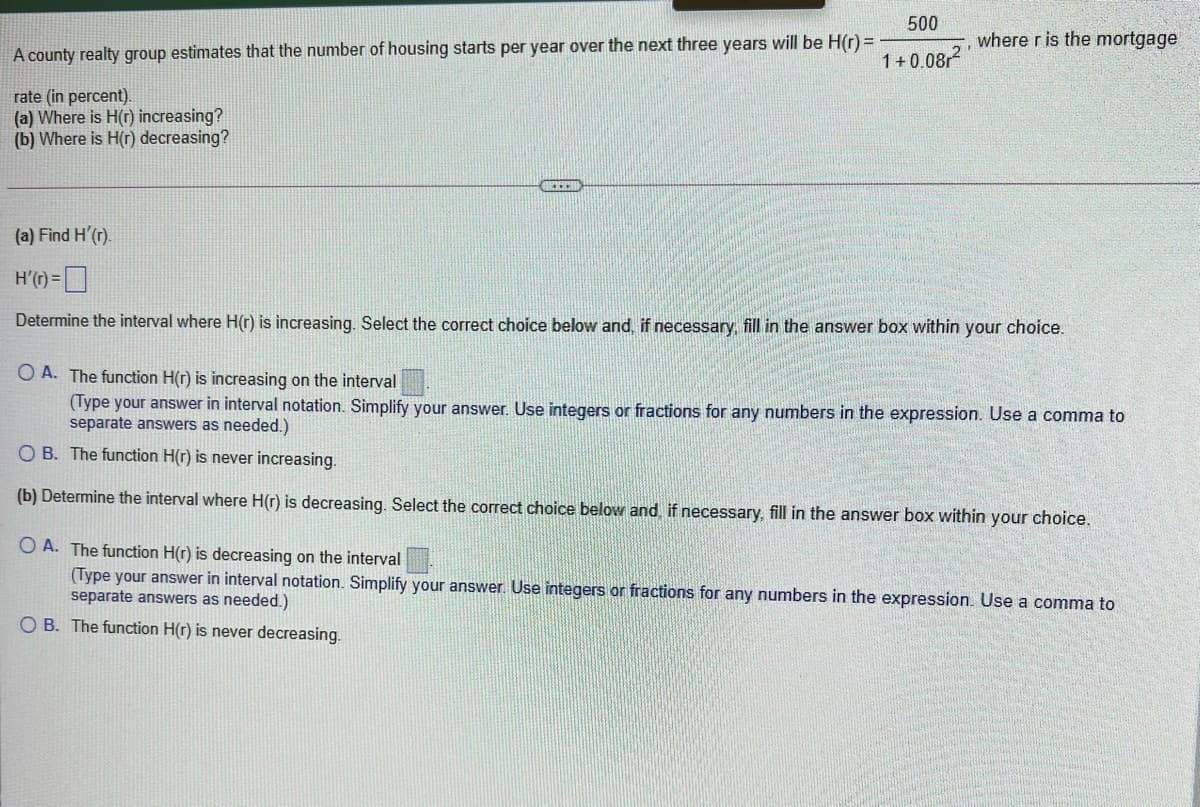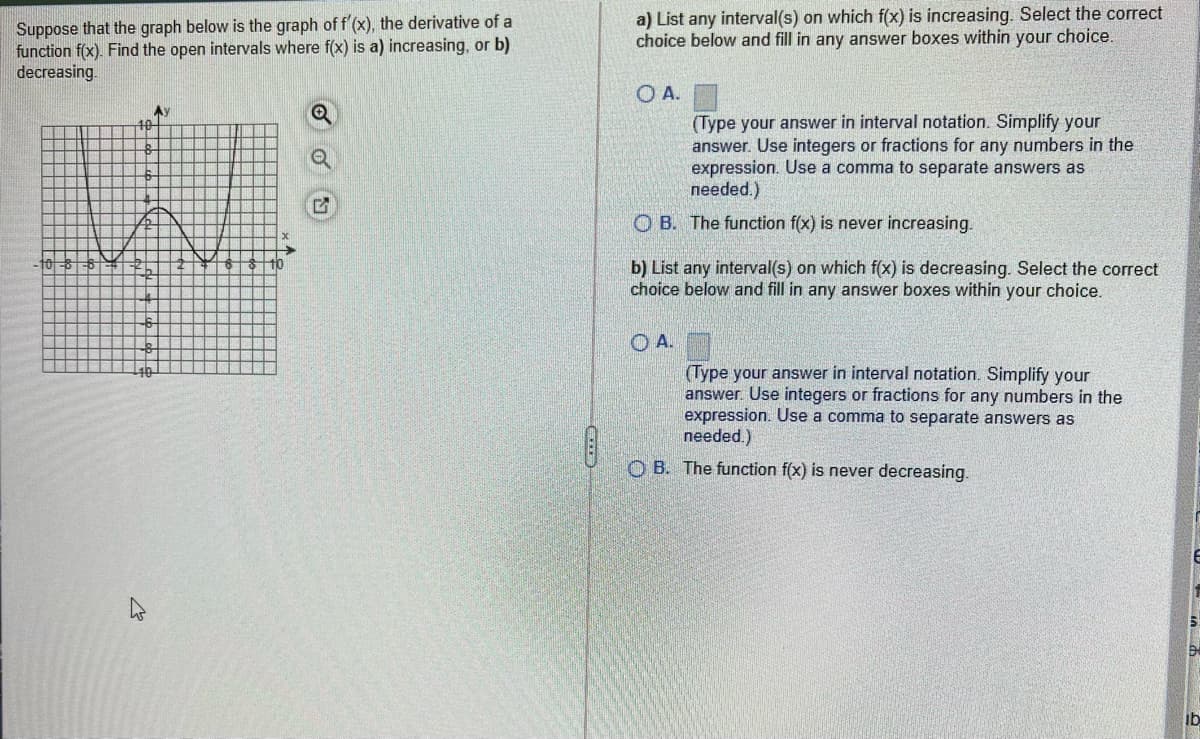500 where r is the mortgage A county realty group estimates that the number of housing starts per year over the next three years will be H(r) = 1+0.08r rate (in percent). (a) Where is H(r) increasing? (b) Where is H(r) decreasing? (a) Find H'(). H'() = Determine the interval where H(r) is increasing. Select the correct choice below and, if necessary, fill in the answer box within your choice. O A. The function H(r) is increasing on the interval (Type your answer in interval notation. Simplify your answer. Use integers or fractions for any numbers in the expression. Use a comma to separate answers as needed.) O B. The function H(r) is never increasing. (b) Determine the interval where H(r) is decreasing. Select the correct choice below and, if necessary, fill in the answer box within your choice. O A. The function H(r) is decreasing on the interval (Type your answer in interval notation. Simplify your answer. Use integers or fractions for any numbers in the expression. Use a comma to separate answers as needed.) O B. The function H(r) is never decreasing.
500 where r is the mortgage A county realty group estimates that the number of housing starts per year over the next three years will be H(r) = 1+0.08r rate (in percent). (a) Where is H(r) increasing? (b) Where is H(r) decreasing? (a) Find H'(). H'() = Determine the interval where H(r) is increasing. Select the correct choice below and, if necessary, fill in the answer box within your choice. O A. The function H(r) is increasing on the interval (Type your answer in interval notation. Simplify your answer. Use integers or fractions for any numbers in the expression. Use a comma to separate answers as needed.) O B. The function H(r) is never increasing. (b) Determine the interval where H(r) is decreasing. Select the correct choice below and, if necessary, fill in the answer box within your choice. O A. The function H(r) is decreasing on the interval (Type your answer in interval notation. Simplify your answer. Use integers or fractions for any numbers in the expression. Use a comma to separate answers as needed.) O B. The function H(r) is never decreasing.
College Algebra
7th Edition
ISBN:9781305115545
Author:James Stewart, Lothar Redlin, Saleem Watson
Publisher:James Stewart, Lothar Redlin, Saleem Watson
Chapter4: Exponential And Logarithmic Functions
Section: Chapter Questions
Problem 3CC: If xis large, which function grows faster, f(x)=2x or g(x)=x2?
Related questions
Question

Transcribed Image Text:500
where r is the mortgage
A county realty group estimates that the number of housing starts per year over the next three years will be H(r) =
1+0.08
rate (in percent).
(a) Where is H(r) increasing?
(b) Where is H(r) decreasing?
(a) Find H'().
H'() =D
Determine the interval where H(r) is increasing. Select the correct choice below and, if necessary, fill in the answer box within your choice.
O A. The function H(r) is increasing on the interval
(Type your answer in interval notation. Simplify your answer. Use integers or fractions for any numbers in the expression. Use a comma to
separate answers as needed.)
O B. The function H(r) is never increasing.
(b) Determine the interval where H(r) is decreasing. Select the correct choice below and, if necessary, fil in the answer box within your choice.
O A. The function H(r) is decreasing on the interval
(Type your answer in interval notation. Simplify your answer. Use integers or fractions for any numbers in the expression. Use a comma to
separate answers as needed.)
O B. The function H(r) is never decreasing.

Transcribed Image Text:Suppose that the graph below is the graph of f (x), the derivative of a
function f(x). Find the open intervals where f(x) is a) increasing, or b)
decreasing.
a) List any interval(s) on which f(x) is increasing. Select the correct
choice below and fill in any answer boxes within your choice.
OA.
Ay
10
(Type your answer in interval notation. Simplify your
answer. Use integers or fractions for any numbers in the
expression. Use a comma to separate answers as
needed.)
O B. The function f(x) is never increasing.
b) List any interval(s) on which f(x) is decreasing. Select the correct
choice below and fill in any answer boxes within your choice.
O A.
(Type your answer in interval notation. Simplify your
answer. Use integers or fractions for any numbers in the
expression. Use a comma to separate answers as
needed.)
O B. The function f(x) is never decreasing.
ib
Expert Solution
This question has been solved!
Explore an expertly crafted, step-by-step solution for a thorough understanding of key concepts.
Step by step
Solved in 3 steps with 2 images

Recommended textbooks for you

College Algebra
Algebra
ISBN:
9781305115545
Author:
James Stewart, Lothar Redlin, Saleem Watson
Publisher:
Cengage Learning

College Algebra
Algebra
ISBN:
9781305115545
Author:
James Stewart, Lothar Redlin, Saleem Watson
Publisher:
Cengage Learning